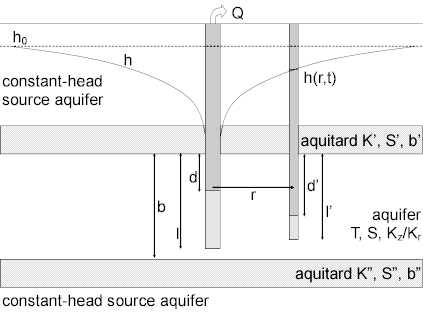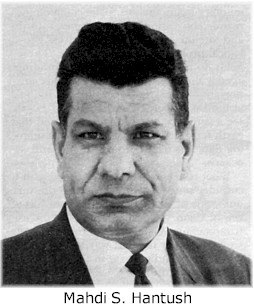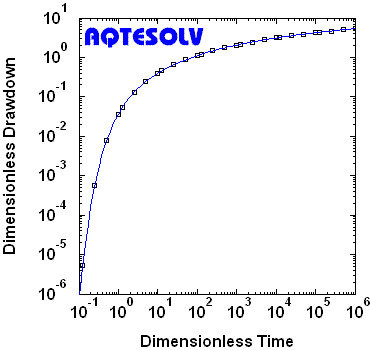Hantush (1960) Solution for Leaky Confined Aquifers
- Assumptions
- Equations
- Data requirements
- Solution options
- Estimated parameters
- Curve matching tips
- Benchmark
- References
Related Solution Methods
- Hantush and Jacob (1955)
- Hantush and Jacob (1955) for step tests
- Neuman and Witherspoon (1969)
- Moench (1985)
Additional Topics

 Hantush (1960) published a mathematical solution that is useful for determining the hydraulic properties (transmissivity and storativity of pumped aquifer; vertical hydraulic conductivity and storage coefficient of aquitard) of leaky confined (semi-confined) aquifers.
Hantush (1960) published a mathematical solution that is useful for determining the hydraulic properties (transmissivity and storativity of pumped aquifer; vertical hydraulic conductivity and storage coefficient of aquitard) of leaky confined (semi-confined) aquifers.
Evaluation of aquifer properties involves matching the Hantush well function to water-level drawdown data collected during a pumping test (aquifer test). The solution assumes storage in leaky compressible aquitard(s) and also accounts for partially penetrating wells (Hantush 1961a,b).
You are not restricted to constant-rate tests with the Hantush solution. AQTESOLV incorporates the principle of superposition in time to simulate variable-rate and recovery tests with this method.
Assumptions
- aquifer has infinite areal extent
- aquifer is homogeneous, isotropic and of uniform thickness
- control well is fully or partially penetrating
- flow to control well is horizontal when control well is fully penetrating
- aquifer is leaky confined
- flow is unsteady
- water is released instantaneously from storage with decline of hydraulic head
- diameter of control well is very small so that storage in the well can be neglected
- aquitards have infinite areal extent, uniform vertical hydraulic conductivity, storage coefficient and uniform thickness
- aquitards are overlain or underlain by an infinite constant-head plane source
- flow in the aquitards is vertical
Equations
Hantush (1960) derived an analytical solution for unsteady flow to a fully penetrating well in a homogeneous, isotropic leaky confined aquifer assuming aquitard storage. The Laplace transform solution is as follows:
where
- is thickness of first aquitard [L]
- is thickness of second aquitard [L]
- is vertical hydraulic conductivity of first aquitard [L/T]
- is vertical hydraulic conductivity of second aquitard [L/T]
- is modified Bessel function of second kind, order zero
- is Laplace transform variable
- is pumping rate [L³/T]
- is radial distance from pumping well to observation well [L]
- is drawdown [L]
- is storativity [dimensionless]
- is storativity of first aquitard [dimensionless]
- is storativity of second aquitard [dimensionless]
- is elapsed time since start of pumping [T]
- is transmissivity [L²/T]
Hantush (1960) also derived an asymptotic solution ( well function) for drawdown in the pumped aquifer at short values of time:
or
The solution assumes small values of time, i.e., when < and < .
The early-time approximate solution can be modified for partial penetrating wells and anisotropy using the approach of Hantush (1961a, b).
At large distances, the effect of partial penetration becomes negligible when
where
- is aquifer thickness [L]
- is radial hydraulic conductivity of aquifer [L/T]
- is vertical hydraulic conductivity of aquifer [L/T]
Data Requirements
- pumping and observation well locations
- pumping rate(s)
- observation well measurements (time and displacement)
- partial penetration depths (optional)
- saturated thickness (for partially penetrating wells)
- hydraulic conductivity anisotropy ratio (for partially penetrating wells)
Solution Options
- variable pumping rates
- multiple pumping wells
- multiple observation wells
- partially penetrating pumping and observation wells
- boundaries
Estimated Parameters
- (transmissivity)
- (storativity)
- (leakage parameter, first aquitard)
- (leakage parameter, first aquitard)
- (leakage parameter, second aquitard)
- (leakage parameter, second aquitard)
The Report view shows aquitard properties ( and ; and ) computed from the leakage parameters ( and ).
Early-Time Solution
- (transmissivity)
- (storativity)
- (leakage parameter)
- (hydraulic conductivity anisotropy ratio)
- (aquifer thickness)
Curve Matching Tips
- Use the Cooper and Jacob (1946) solution to obtain preliminary estimates of aquifer properties.
- Choose Match>Visual to perform visual curve matching using the procedure for type curve solutions.
- Use active type curves for more effective visual matching with variable-rate pumping tests.
- Select values of , and from the Family and Curve drop-down lists on the toolbar.
- Use parameter tweaking to perform visual curve matching and sensitivity analysis.
- Perform visual curve matching prior to automatic estimation to obtain reasonable starting values for the aquifer properties.
- For < 0.5, all of the type curves in the early-time solution have a similar shape (Kruseman and de Ridder 1994); hence, it is often difficult to obtain a unique match with the early-time solution when 0 ≤ ≤ 0.5.
Benchmark

References
Hantush, M.S., 1960. Modification of the theory of leaky aquifers, Jour. of Geophys. Res., vol. 65, no. 11, pp. 3713-3725.
Hantush, M.S., 1961a. Drawdown around a partially penetrating well, Jour. of the Hyd. Div., Proc. of the Am. Soc. of Civil Eng., vol. 87, no. HY4, pp. 83-98.
Hantush, M.S., 1961b. Aquifer tests on partially penetrating wells, Jour. of the Hyd. Div., Proc. of the Am. Soc. of Civil Eng., vol. 87, no. HY5, pp. 171-194.